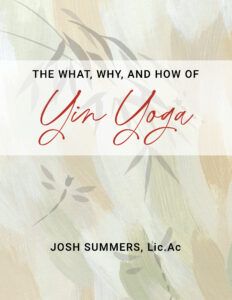View Previous Module View Next Lesson
In this series of 5 lessons, I cover the four principles of Yin Meditation, which are analogous to the principles of Yin Yoga. In exploring Yin Meditation, I’ll speak to how an attitude of receptivity, as well as the permission to creatively make choices, form the foundation of this approach to meditation. In this way, Yin Meditation offers less of a “rule-based” approach to meditation and more of a creative approach to self-exploration and development where the meditator is both the artist and the creative subject.
You can listen to all four lessons in this module here, and then download the Yin Meditation Instructions below and begin practicing:
Or view each lesson individually:
- Relaxing the Mind: I look at how meditation instructions function like filters – functioning either exclusively or inclusively – and also how Yin Meditation may be the best antidote to tension and frustration in your meditation practice.
- Playing Your Mental Edge: In this lesson, I discuss ideas around appropriate postures for meditation, what it means to play your mental edge, and how this approach cultivates a sensitivity to cause and effect, or Karma. The general “mental posture” within Yin Meditation is for your mind to be receptive and open to the full range of your inner experience. But with such an open ended approach, it’s not uncommon for challenging emotions and themes to arise within your practice. I suggest handling these strong mental/emotional energies in the same manner that you might negotiate strong sensation in the body during a Yin Yoga posture.
- The Art of Relaxing Conflict in Meditation: In this lesson, I look at how a Yin Meditation can soften common tensions and conflict that occur for people when they meditate. I’ll be discussing the function of relaxed receptivity in Yin Meditation, how it’s ok to let your mind wander, and how all aspects of the meditative process serve your a process of learning, understanding, and cultivation of wisdom.
- Staying Still for Time: In this lesson, I answer common questions that I receive from students about how long and when you should meditate. I also look at the importance of being firm AND flexible when you establish your meditation practice. By committing to a fixed time, you will inevitably go through phases of calm, agitation, boredom, restlessness; there will be periods of wondering when it will end, and possibly periods of time of not wanting it to end. And in sitting through all these experiences — riding these internal waves — you will start to get to know your inner world better.
- Yin Meditation: The Instructions: Rather than trying to domesticate your thought process, Yin Meditation offers a process for refining your understanding of how your inner world works. Approaching your meditation with a receptive attitude is the least intrusive way of getting to know the natural terrain of your inner landscape. In this lesson, I unpack the three main principles of Yin Meditation: 1) a perch, 2) receptivity, and 3) permission. Each of these three elements will promote a gentler and more authentic way to work with your mind as it is in meditation.
Downloads
Instructions: Practice 3 sessions of at least 20 minutes each, and journal 15 minutes after each session about your experience.
Mark this module as favorite / complete:
[lms_favorite] [lms_complete]

